Have insights to contribute to our blog? Share them with a click.

Build scalable, adaptable architectures ready for tomorrow’s challenges
Talk to an Integration Expert
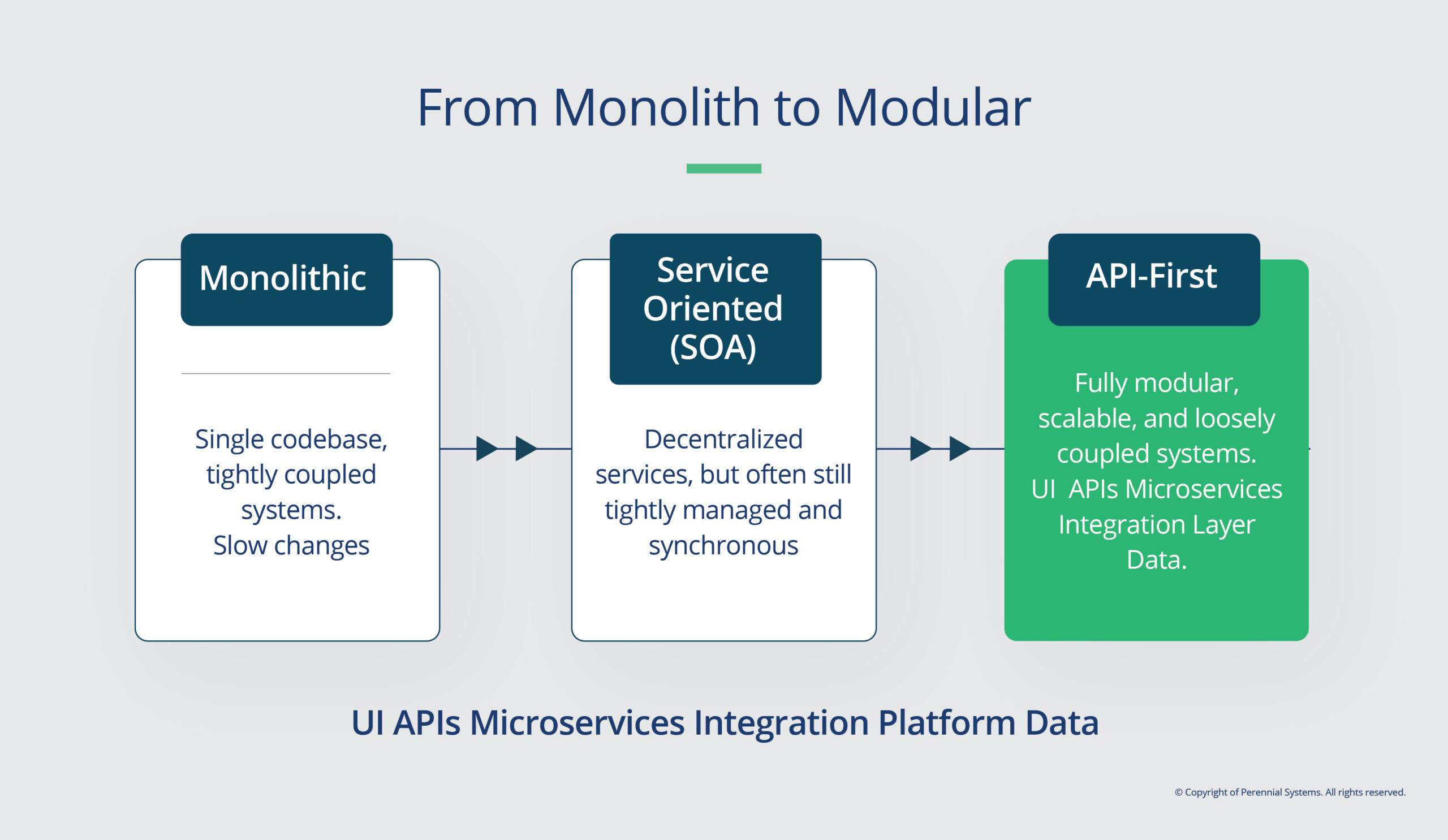
Why Future-Proofing Now?
The pace of digital transformation has shifted from a long-term initiative to an immediate imperative. In a world driven by SaaS sprawl, AI adoption, and increasing user expectations, the ability to integrate, evolve, and scale tech systems determines competitive edge.
Legacy systems and point-to-point integrations can’t keep up with today’s demands - let alone tomorrow’s. Enterprises face:
- Exploding service ecosystems - every function now involves a dozen APIs.
- Vendor diversification - multi-cloud and hybrid stacks are the norm.
- Global complexity - data regulations, latency issues, and regional nuances require adaptable systems.
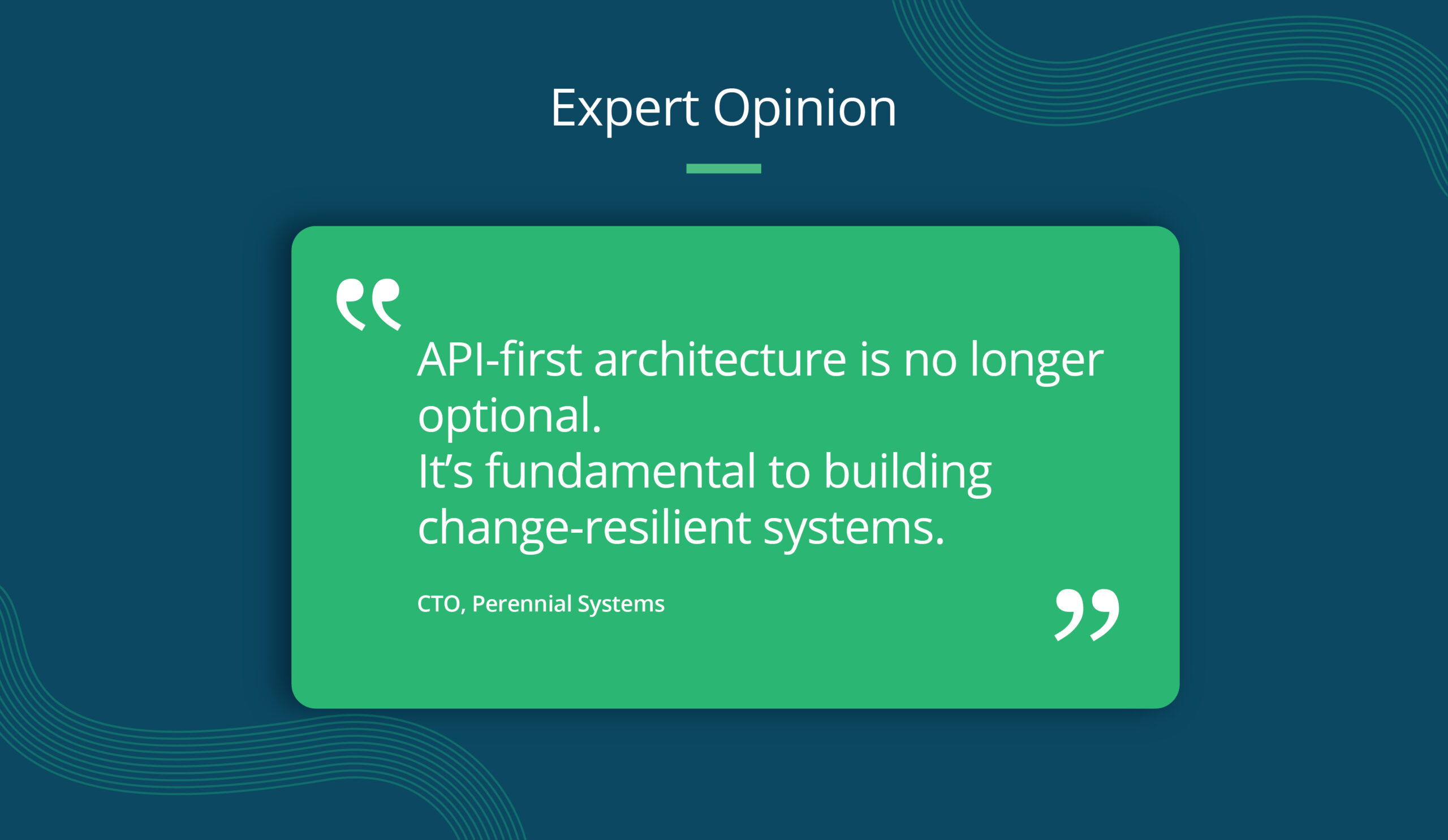
The Case for API-First Thinking
An API-first approach goes beyond technical design. It’s a cultural and architectural strategy that places interoperability, reusability, and external consumption at the center of system thinking.
Key business benefits:
- Agility: Decouple frontends from backends for faster product rollouts.
- Scalability: Scale individual services without rearchitecting the whole system.
- Resilience: Reduce single points of failure with loosely coupled services.
- Developer Velocity: APIs act as contracts - empowering teams to build in parallel.
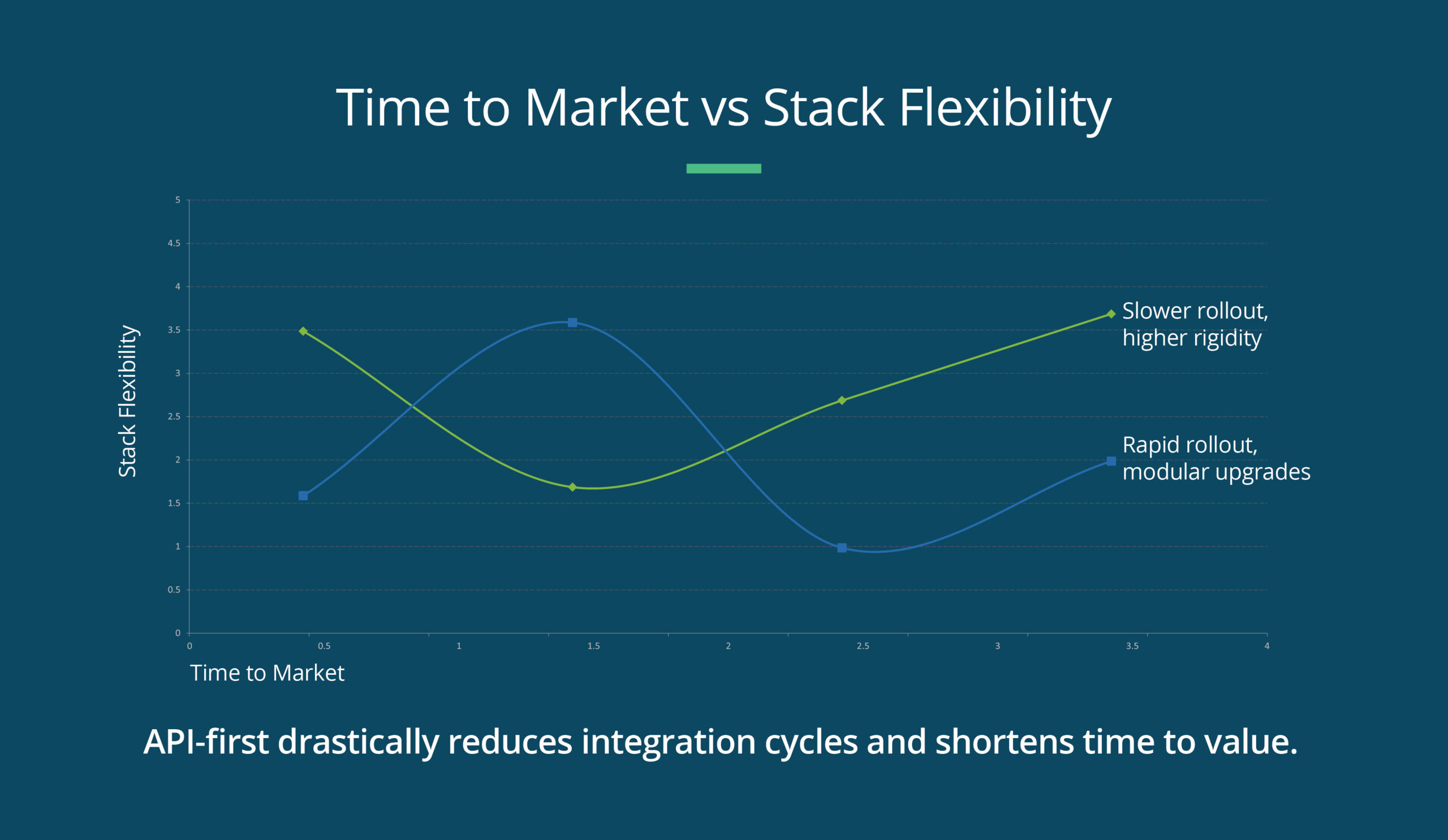
What This Article Will Deliver
This guide is designed to help CTOs, Heads of Engineering, and Solution Architects strategically plan their stack’s evolution. You’ll learn:
- The real difference between API development and API integration
- How to choose the right integration approach (point-to-point vs. platform vs. middleware)
- A comparison of top API integration platforms
- Emerging patterns like API gateways, event-driven APIs, and low-code integrations
- Best practices and mistakes to avoid when modernizing
- A practical decision framework for integration architecture
Whether you're preparing for multi-cloud growth, ecosystem partnerships, or just trying to streamline internal complexity, this guide will help you make long-term, scalable decisions.
What’s at Stake: The Real Cost of Rigid Stacks
Rigid systems don’t just slow down innovation - they bleed money. Inflexible architectures result in:
- Integration rework with every product update
- Outages caused by cascading dependencies
- Ballooning technical debt as teams patch instead of replatform
- Lost business opportunities due to slow partner onboarding

The bottom line: a brittle stack limits your ability to compete, scale, and evolve. Future-proofing is not just technical hygiene - it's a business strategy.
2. Executive Summary

Across industries, enterprises are racing to modernize their infrastructure - but not all modernization efforts are created equal. The maturity of your API strategy determines how fast you can:
- Launch new services
- Integrate with partners
- Enter new markets
- Support product-led growth
- Transition to modular, cloud-native systems
In short, API maturity equals business agility. It's what separates leaders from laggards in today's software economy.
Modern CTOs aren’t just buying tools. They’re building composable ecosystems - and the glue is smart, scalable API development and integration.
Key Learnings at a Glance
- Understand the difference between API development and integration - and why it matters
- Identify which integration strategy fits your current and future tech stack
- Compare top-tier API integration platforms using a CTO-friendly decision framework
- Learn how to handle legacy modernization without business disruption
- Avoid common pitfalls that increase technical debt and slow down teams
- Get future-ready with insights on event-driven APIs, gateways, and low-code orchestration
What You Can Action Immediately
- Audit your current stack: Are your services modular, API-accessible, and reusable?
- Evaluate integration pain points: Look beyond connectivity - what’s slowing teams down?
- Choose one internal use case to rewire with an API-first approach - measure the impact.
- Align teams around a platform strategy - not just a toolset, but a governance model.
- Invest in documentation and versioning - they're as strategic as code
3. Why Future-Proofing Starts with APIs
The API-First Paradigm Explained
Future-proofing starts with treating APIs not as technical afterthoughts, but as strategic products. API-first architecture mandates that APIs are the first class citizens in any application lifecycleplanned, designed, and versioned with intent.
In this model, the API is no longer a side effect of your product; it is the product interface. This shift ensures:
- Faster dev cycles
- Better internal alignment between frontend/backend teams
- Improved third-party integration readiness
When CTOs prioritize an API-first approach, they unlock modularity, reuse, and long-term agility.
Decoupling: Your Key to Business Continuity
Decoupling systems using APIs isolates failure domains, accelerates recovery, and enables independent evolution of services. When services are tightly coupled, even a minor change can lead to cascading failures.
Think: Payments system going down shouldn’t impact authentication or customer support workflows.
APIs introduce buffers that prevent cross-service disruption.
APIs as Change Accelerators: New Markets, M&A, Replatforming
When expanding into new geographies, migrating platforms, or onboarding acquired systems, APIs become your primary integration surface. Well-documented, versioned APIs reduce time-to-market during strategic shifts:
- Launching mobile experiences
- White-labeling platforms
- Supporting new payment providers or logistics partners
APIs turn enterprise tech from a liability into a launchpad.
Reducing Tech Debt Through Standardized Contracts
APIs allow you to codify expectations through standards like OpenAPI and GraphQL schemas. Contracts minimize ambiguity and serve as guardrails for developers.
Standardized APIs mean:
- Fewer bugs from interface mismatches
- Predictable integration points
- Scalable onboarding for dev teams or partners
Technical debt decreases as consistency increases.
Business Outcomes: Faster Releases, Better SLAs, Improved DX
From business perspective, an API-first model translates into:
- Faster releases via CI/CD pipelines for microservices
- Improved SLAs with observability, retries, and rate limits
- Better DX (Developer Experience) driving adoption of internal tools and external partner APIs
"We Will" Commitment: Map Your Architecture’s Current vs. Target API Coverage
- We will audit each service for its API maturity
- We will define target coverage for internal and public APIs
- We will assign service owners for API lifecycle governance
4. Implementation vs Integration vs Interface
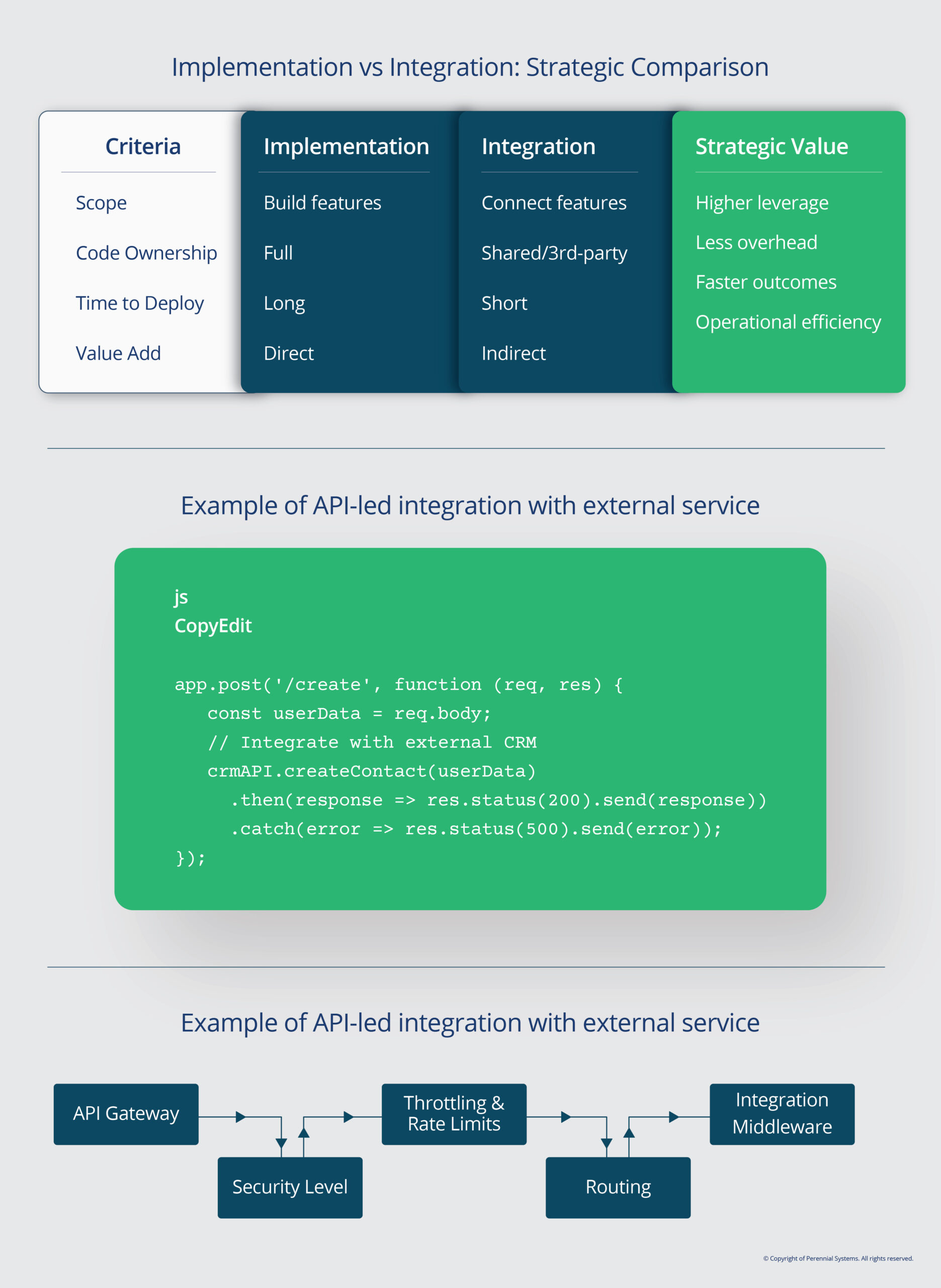
Defining the Stack: Implementation, Integration, Interface
- Implementation is the business logic: the actual code behind a service.
- Interface defines how others access it - API specs, payloads, versioning.
- Integration stitches systems together - through middleware, queues, or event systems.
Understanding the distinction prevents scope creep and architecture bloating.
When to Build, When to Connect
Not every challenge needs custom code. Mature teams evaluate:
- Is there a reliable connector for this task?
- Would building an API give us more control or flexibility?
This strategic mindset drives velocity and maintainability.
Case Study: SaaS Platform with Poor Interface Contracts
A B2B SaaS platform failed to version its APIs. New feature rollouts broke downstream integrations, leading to customer churn. Post-mortem led to:
- Clear contract definitions
- API versioning roadmap
- Documentation SLAs
Outcome: 30% drop in support tickets, faster onboarding.
Interface Without Integration = Car Without Engine
A great UI or API spec without real connections behind it is useless. Integration handles the orchestration:
- Syncing data across tools
- Validating business logic
- Handling errors and retries
API Gateways and Middleware – Role in Orchestration
Gateways provide traffic control, auth, rate limiting. Middleware ensures:
- Schema transformations
- Error logging
- Retry mechanisms
Together, they enable composable, robust systems.
"We Will" Commitment: Recommend API Layering Strategy for Your Stack
- We will diagram internal vs external API surfaces
- We will identify where orchestration logic lives
- We will define fallback strategies and retry logic paths
5. Choosing the Right API Platform
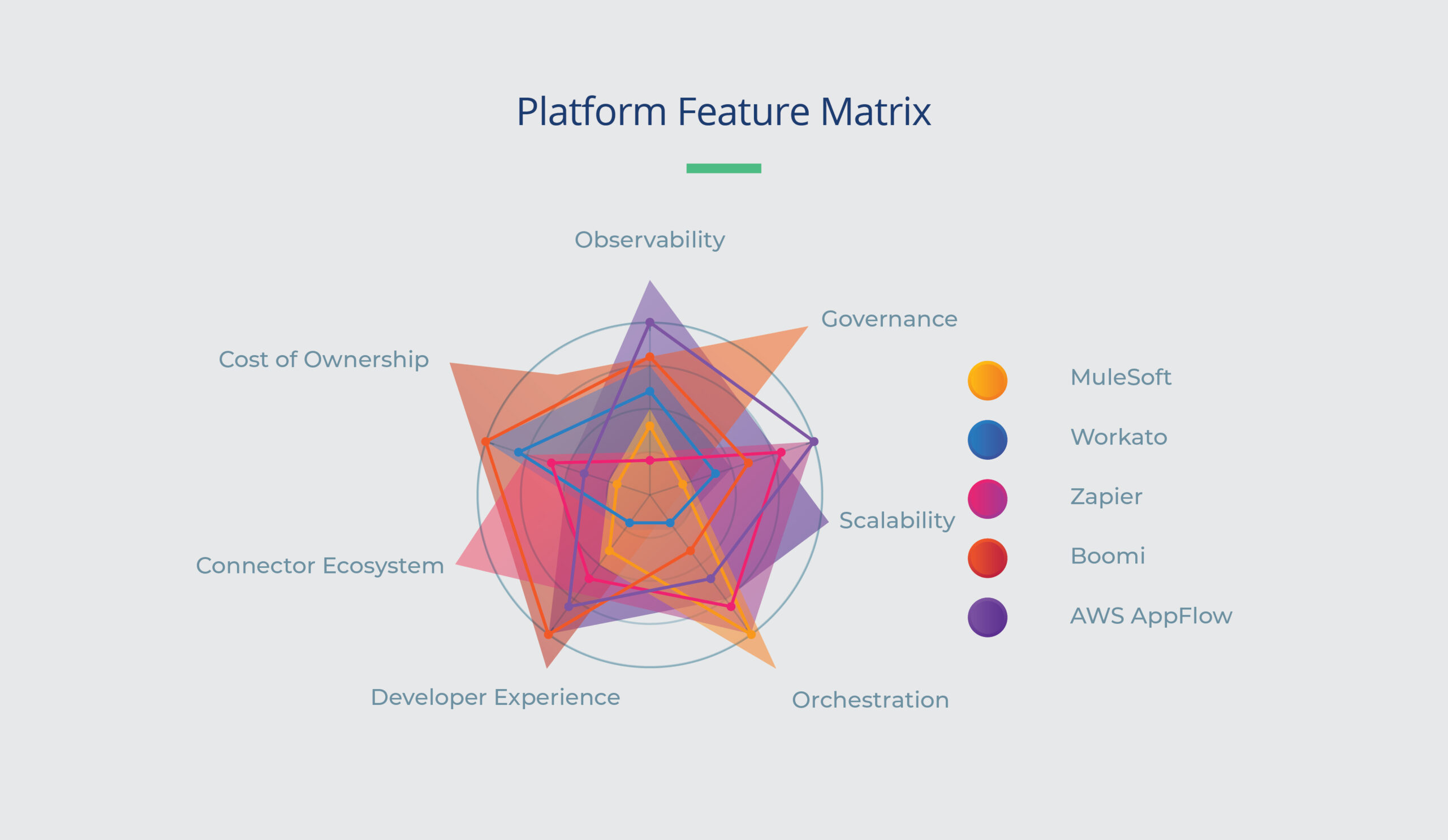
What Makes an API Platform Future-Proof?
Future-proofing your integration strategy goes beyond selecting a platform that addresses your current needs. It means choosing a solution that can evolve with your business, technology stack, and product complexity.
A future-proof platform typically offers:
Modularity and Extensibility: Support for plugins, custom connectors, and SDKs to extend platform behavior as business logic changes.
Multi-environment Support: Flexibility to deploy in cloud, hybrid, or on-premise environments to meet enterprise security and compliance requirements.
Support for Emerging Standards: Compatibility with gRPC, GraphQL, WebSockets, event-driven systems, and streaming protocols.
Active Ecosystem and Roadmap: Regular feature releases, growing documentation, and a vibrant developer or partner community.
Selecting a future-proof platform reduces the risk of costly re-platforming exercises and enables teams to adapt faster as integration needs mature.
Key Feature Dimensions for Evaluation
Choosing an API platform requires a close evaluation of core features that directly affect performance, scalability, developer experience, and governance. The following dimensions are critical:
1. Observability
Modern integrations must be trackable, debuggable, and measurable. Platforms should offer:
Real-time monitoring of transactions and failures
Integration with third-party logging and tracing tools (e.g., Datadog, OpenTelemetry)
Support for distributed tracing to follow API calls across services
Historical logs and performance dashboards for optimization and audits
Observability is crucial when dealing with complex workflows and multi-party systems where even minor issues can escalate into major operational problems.
2. Governance
A scalable API integration platform must support robust governance to control data access, usage policies, and API lifecycle.
Key features to evaluate include:
Role-based access control (RBAC) for multi-team environments
Version management of APIs and workflows
Policy enforcement capabilities (e.g., rate limiting, schema validation)
Change management tools and approval workflows
This becomes especially important in regulated industries or enterprises with multiple departments managing their own integration logic.
3. Scalability
The platform must be able to scale horizontally and vertically with business growth.
Native support for autoscaling and distributed execution
Resiliency under load, including retry queues and throttling
Multi-tenant architecture support for internal platform teams
Horizontal scaling of APIs and tasks across regions
Scalability is not just about handling more traffic - it’s about ensuring consistency, uptime, and performance at every scale tier.
4. Orchestration
Orchestration capabilities define how easily business logic can be composed and managed.
Visual or declarative workflow builders for chaining APIs
Support for conditions, branches, retries, and fallback logic
Event triggers and scheduled jobs to initiate workflows
Integration with other services like queues, data lakes, and identity systems
Effective orchestration reduces the need to hardcode workflows into backend services and creates a more maintainable integration architecture.
Low-Code iPaaS vs Full-Control API Platforms
There is no one-size-fits-all API platform. The decision often comes down to your team's technical maturity and integration complexity.
Low-Code iPaaS Platforms (e.g., Zapier, Workato, Boomi)
Advantages:
Fast setup and deployment
Designed for business users and non-technical teams
Rich ecosystem of prebuilt connectors
Limitations:
Limited flexibility for edge cases
Black-box execution logic
Challenging to debug and version in CI/CD pipelines
These platforms are excellent for organizations with smaller IT teams or those looking to prototype quickly.
Full-Control Developer Platforms (e.g., AWS AppFlow, MuleSoft, self-hosted options)
Advantages:
High degree of customization
Integrates seamlessly with CI/CD and version control systems
Better suited for complex event-driven or large-scale workflows
Limitations:
Requires technical expertise
Higher setup and operational complexity
The right choice depends on whether you are optimizing for speed or long-term control.
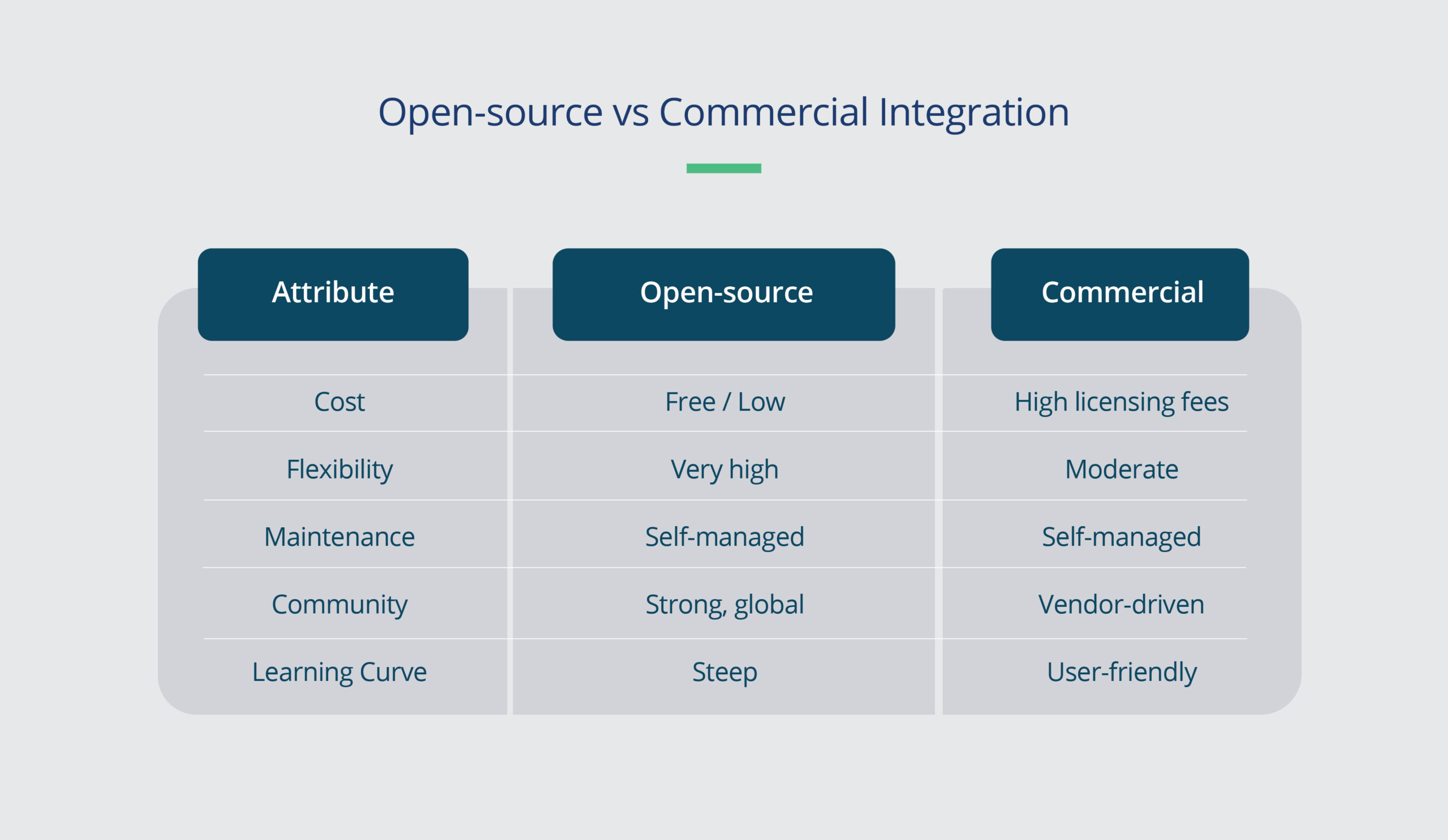
Fit vs. Force: Platform Evaluation Framework
When comparing platforms, use a “fit vs. force” framework to determine if the platform naturally aligns with your existing systems and workflows.
Criterion | Fit (Desirable) | Force (Problematic) |
|---|---|---|
Stack Compatibility | Native connectors, APIs, SDKs | Requires workarounds or manual wrapping |
Developer Workflow | Integrates with Git, CI/CD, CLI tooling | UI-only workflows with no versioning |
Data Model Alignment | Supports existing schemas and formats | Requires complex transformations |
Business Logic Support | Handles your use cases with minimal logic | Requires extensive scripting and testing |
A good platform will align with your architecture without needing to be bent out of shape.

Total Cost of Ownership (TCO) Considerations
Pricing structures vary widely among platforms and often do not reflect total costs.
Key considerations:
Direct Costs: Subscription fees, usage-based billing, connector pricing
Indirect Costs: Time spent on debugging, training, documentation, and vendor support
Scalability Costs: How does pricing change with growth in volume or teams?
Beware of usage-based pricing models that charge per workflow execution or connector. These may seem affordable initially but can become cost-prohibitive as volumes increase.
Our Approach: Tailored Platform Evaluation Scorecard
At Perennial, we believe in making decisions grounded in technical and business context. That’s why we co-create a platform evaluation scorecard tailored to your environment. This includes:
Compatibility with current and planned tech stacks
Business-critical use case alignment
Scalability projections and cost modeling
Governance and compliance needs
This scorecard becomes the foundation for selecting, onboarding, and scaling the right platform - without guesswork or lock-in regrets.
6. Integration Patterns That Scale
Why Integration Architecture Matters
As businesses grow, integrations become more complex, spanning customer data, internal systems, and external partners. Choosing the right integration pattern is critical to maintaining performance, observability, and long-term scalability.
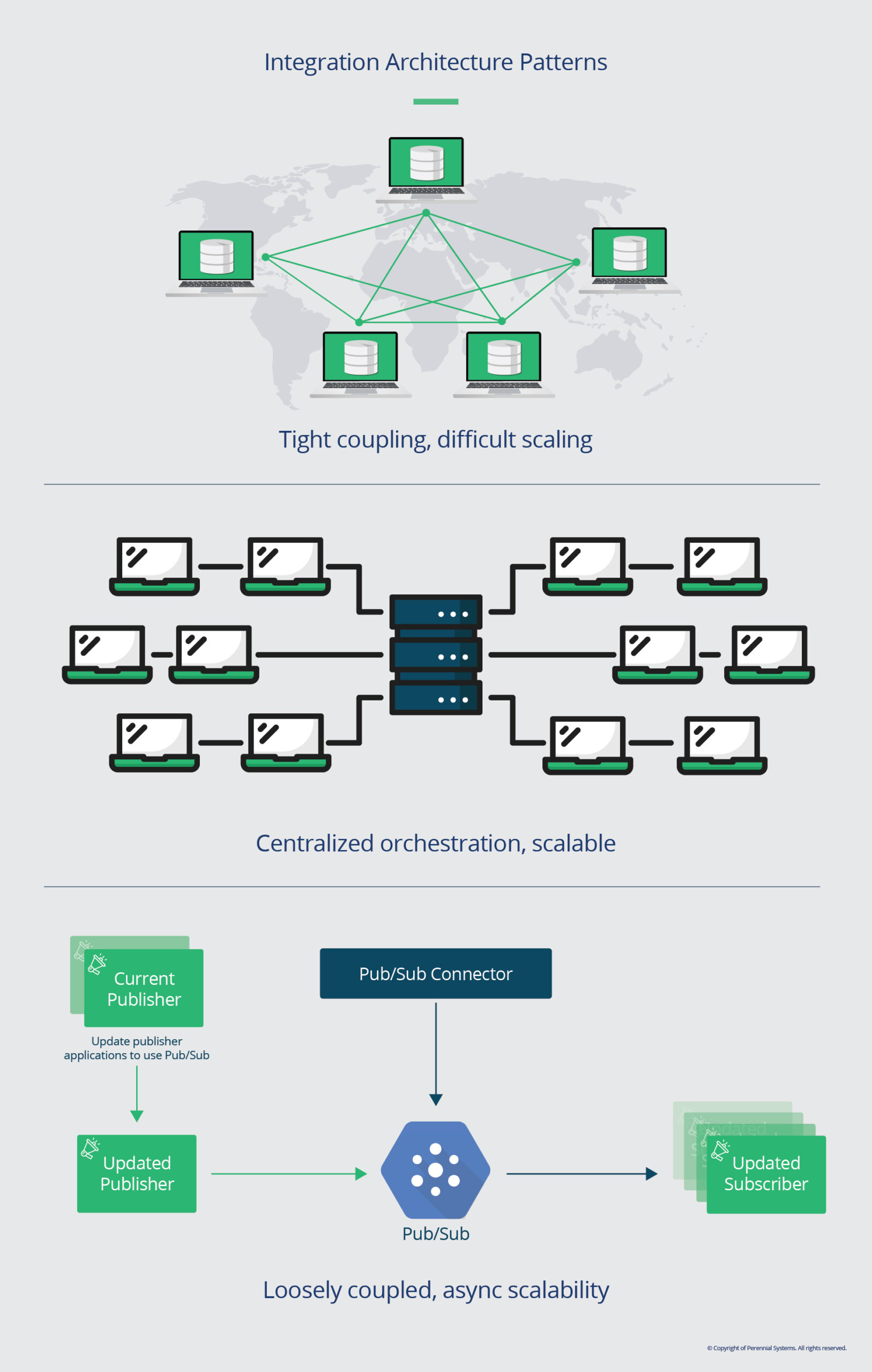
Point-to-Point: Simplicity with Limitations
Point-to-point integration connects two systems directly. While quick to implement, it quickly creates complexity as more systems are added.
Advantages:
Minimal setup
Easy to understand
Disadvantages:
Poor scalability
No centralized control
High coupling leads to fragile systems
This model can work for prototypes or very small integrations but often leads to tangled dependencies over time.
Hub-and-Spoke: Centralized Management and Reusability
Hub-and-spoke architecture introduces a central integration hub that manages communication between systems.
Benefits:
Reusable connectors
Centralized error handling and monitoring
Better governance and control
Ideal Use Cases:
Multi-system data sync
Internal workflows (e.g., lead routing, ERP sync)
This model promotes better structure and reduces duplication, particularly useful for medium-sized enterprises or growing teams with internal platform needs.
Event-Driven Architecture: Loose Coupling and High Throughput
In event-driven integration, services communicate by publishing and subscribing to events. This promotes loose coupling and supports asynchronous, scalable systems.
Benefits:
Decoupled systems that scale independently
Supports real-time or near-real-time updates
Enables multi-team, multi-region collaboration
Challenges:
Requires robust event schemas and versioning
Needs to address idempotency, replay logic, and delivery guarantees
Event-driven design is a strong fit for product and engineering teams building customer-facing platforms, notification systems, or real-time analytics workflows.
Choosing the Right Pattern by Use Case
Integration Scenario | Recommended Pattern |
|---|---|
One-off webhook connection | Point-to-Point |
CRM ↔ ERP multi-system sync | Hub-and-Spoke |
Real-time notifications | Event-Driven |
Data ingestion from APIs | Hybrid (Hub + Event Bus) |
Internal dashboard updates | Hub-and-Spoke |
Customer action tracking | Event-Driven |
Most organizations eventually adopt a hybrid approach, choosing patterns based on the scale, latency, and reusability requirements of each workflow.
Migration Mistakes to Avoid
Many teams underestimate the complexity involved in evolving their integration architecture. Common pitfalls include:
Treating event-driven systems as just faster webhooks without redesigning for idempotency and ordering
Migrating without observability tooling in place
Neglecting schema standardization, leading to brittle event contracts
Overloading the integration hub with too much business logic, defeating its modular intent
Migration must be treated as an architecture project - not just an implementation change.
Our Approach: Reference Architecture Design
We collaborate with clients to design modern reference architectures that scale with their business and engineering team capabilities.
A robust reference architecture includes:
Message brokers and event buses for async workflows
Unified monitoring and observability layers
Versioned API contracts and schema registries
Governance gates and logging pipelines
Retry and failure handling patterns
This forms the blueprint for consistent, scalable integration across internal services and external systems.
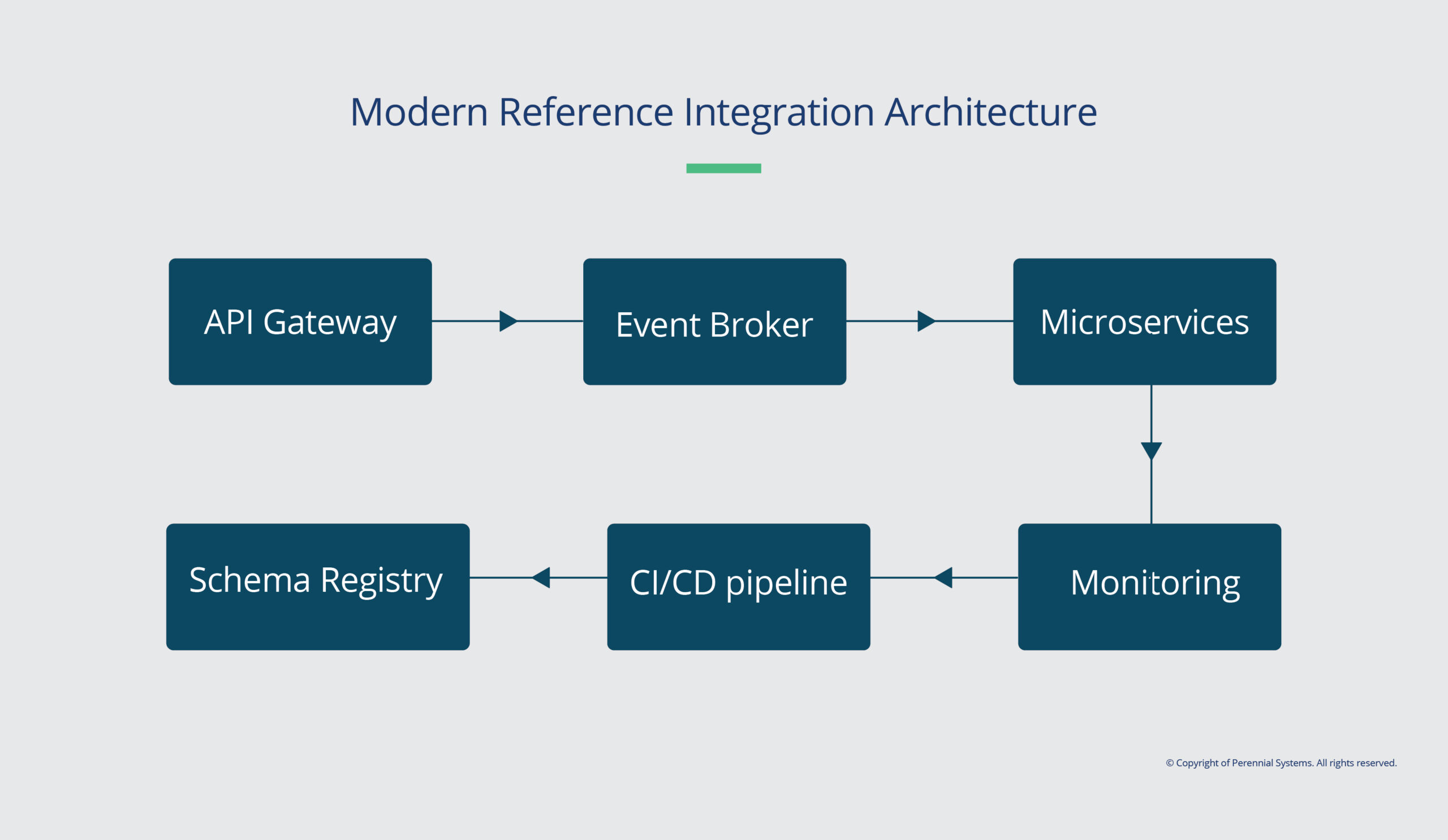
7. Native Integration vs API-Connected Software
Modern business applications offer two primary ways to integrate: native integrations and API-based connections. While both aim to enable data flow between systems, they differ significantly in setup, flexibility, and long-term implications.
What’s the Difference?
Feature | Native Integration | API-Based Integration |
|---|---|---|
Setup Time | Instant / One-click | Requires development or middleware |
Flexibility | Limited to vendor's preset flows | Highly customizable |
Technical Skill | Low | Medium to High |
Vendor Lock-in | High risk | Low – portable and reusable |
Ideal For | Common use cases (CRM ↔️ Email, CRM ↔️ ERP) | Complex, evolving, or large-scale use cases |

Native: Fast, Familiar, But Limiting
Native integrations are great for getting started fast:
Set up with login credentials or API keys.
No additional infrastructure or middleware needed.
Features often appear embedded within your main app’s interface.
Example: Your CRM natively syncs with Mailchimp to automatically push contacts into a campaign list - done in two clicks.
But native comes with limitations:
You’re confined to what the vendor thought you'd need.
If you want a two-way sync or complex logic (like conditional triggers), native connectors often fall short.
Advanced use cases might force workarounds or third-party help.
API-Based Integrations: Flexible & Future-Ready
APIs offer unmatched control:
Design workflows tailored to your business logic.
Connect multiple systems - even across vendors or architectures.
Support performance optimization (e.g., caching, batching) and detailed error handling.
Example: Your company needs to unify customer records from a CRM, e-commerce platform, and ticketing tool into a central analytics dashboard. APIs are the only way to make this work seamlessly.
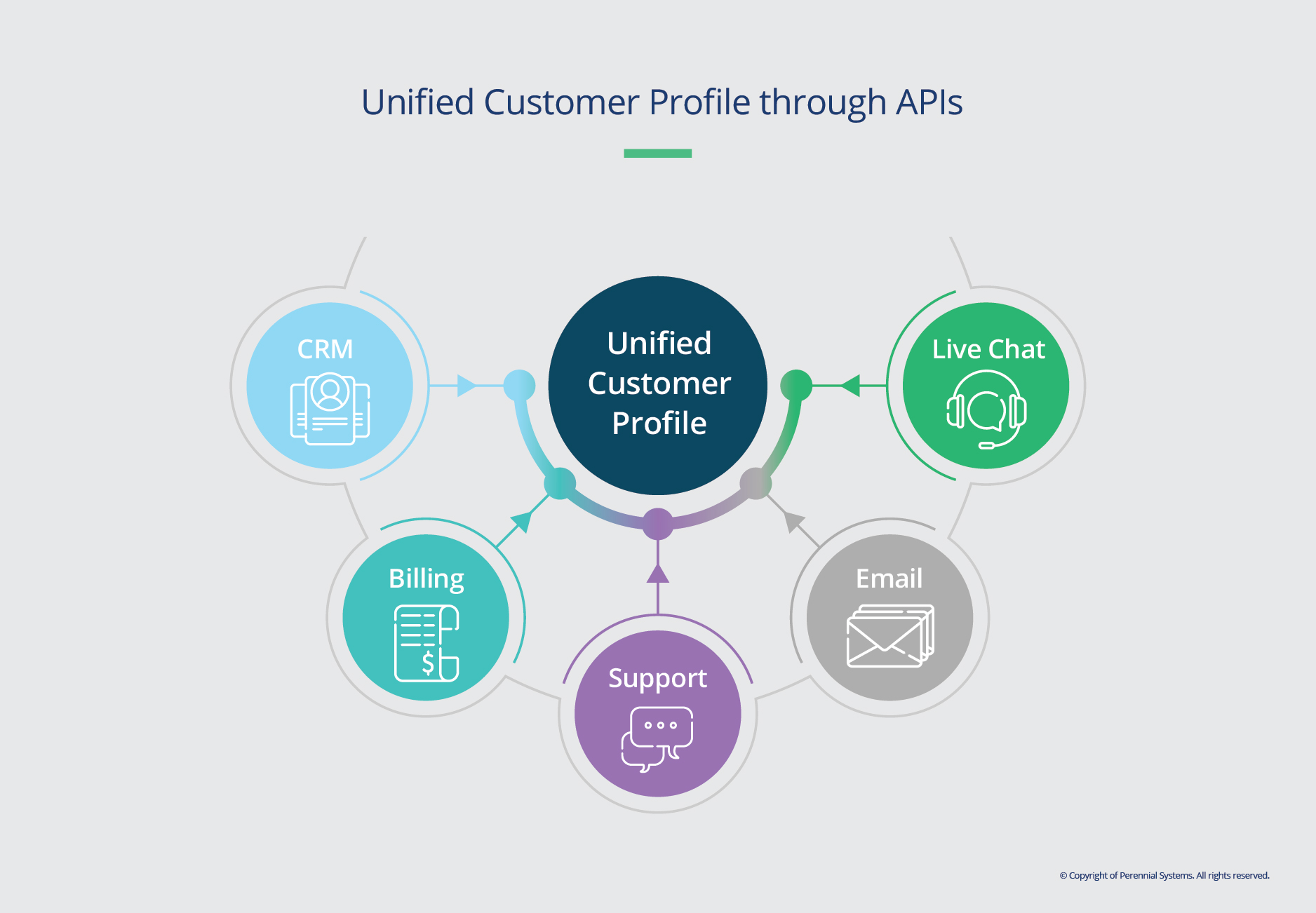
The Cost of Native Lock-In
Native might be easier today, but…
- Switching platforms later? You’ll have to rebuild every integration from scratch.
- Need something custom? You might hit a hard ceiling.
- Advanced features missing? Many native connectors don’t expose full API functionality.
“Relying heavily on native means you’re building your workflows around someone else’s limitations.”
When Native Works Best
- Simple integrations (e.g., syncing lead data between a CRM and marketing tool)
- Low customization requirements
- Stable ecosystems with mature vendors like Salesforce, NetSuite, or ServiceNow
When APIs Are a Better Choice
- Unified data from many sources
- Complex workflows or multi-app orchestration
- Anticipated changes in tech stack (scaling, acquisitions, app switches)
- Performance and security requirements
Integration Audit: Start Here
Before you commit to new integrations, audit your current ones. Here's a simple framework:Integration Name | Type (Native/API) | Lock-in Risk (1–5) | Critical Function? | API Alternative Available? |
|---|---|---|---|---|
CRM ↔️ ERP | Native | 4 | Yes | Yes |
Payroll ↔️ HRIS | API | 2 | No | N/A |
"We Will" Commitments
Inventory all major integrations: native vs API
Score each for lock-in risk and replaceability
Identify easy wins (native integrations that can be swapped out)
Propose API-based rebuilds for high-risk areas
Create a phased roadmap to migrate to more flexible architectures
8. API Integration Best Practices & Governance
Once you’ve chosen APIs, building them right is the key to long-term reliability. This section lays out the foundations for secure, observable, and maintainable integrations.
Security Starts With Smart Authentication
Method | Use Case | Pros | Considerations |
|---|---|---|---|
OAuth 2.0 | App-to-app data access (e.g. CRM ↔️ Ad Tool) | Scoped tokens, secure flow | Requires refresh & revocation setup |
JWT | Stateless auth for microservices | Lightweight, self-contained | Not easily revocable |
mTLS | High-trust inter-service communication | Strong identity guarantees | Certificate management needed |
Observability: See Everything, Fix Quickly
Building is half the work - monitoring is the other half:
Use structured logging (e.g., JSON logs with trace IDs).
Implement distributed tracing to track requests across services.
Set up real-time alerts: latency spikes, error codes, retries.
Use dashboards (Grafana, Datadog) for proactive insights.
"If you can’t measure your integrations, you can’t trust them."
Lifecycle: APIs Change - Prepare for It
Avoid surprises with proper versioning:
Follow semantic versioning: /v1/, /v2/ routes
Deprecate endpoints in stages - don’t just yank them
Maintain backward compatibility wherever possible
Use tools like OpenAPI to define and document contracts
Governance Models: Centralized vs Federated
Decide how your organization will govern integration standards:
Model | Who Controls It | Pros | Challenges |
|---|---|---|---|
Centralized | One team owns policies | Consistency, security | Can slow teams down |
Federated | Each team builds independently | Speed, autonomy | Risk of duplication or bad practices |
Hybrid | Central standards + team autonomy | Balanced model | Needs clear frameworks |
By embracing these best practices, you ensure your integrations aren’t just functional - they’re secure, observable, scalable, and future-proof.
9. KPI-Driven Success: What to Measure, Monitor, and Act On
In the age of API-first business models, visibility isn't optional - it's foundational. APIs are no longer background technical assets; they’re revenue-critical products, data pipelines, and developer experience enablers. That’s why defining clear KPIs for API performance isn’t just good practice - it’s core to scaling with intent.
This section focuses on what great API teams track, why those KPIs matter, and how to move from dashboarding to decision-making.
Leading Indicators: Speed, Stability, and Integration Velocity
Your time-to-market is now heavily dependent on how fast developers can discover, integrate, and deploy using your APIs.
Key KPIs to track:
- Time-to-First-Call (TTFC): Measures the time it takes for a developer to sign up, get credentials, and make their first successful API call.
- Why it matters: A low TTFC means great onboarding, clear docs, and developer-friendly interfaces.
- Average Integration Time: From discovery to production integration.
- Benchmark: <2 days for internal APIs; <7 days for external partners.
- Endpoint Uptime and SLA Adherence: What’s the uptime of mission-critical APIs over time?
- Latency and Error Rates: Track 95th percentile latency and response consistency.
Pro tip: Make integration time visible across teams - treat it like a product onboarding metric, not just a dev stat.
Adoption Metrics: Proof of Use and Stickiness
APIs are only valuable if they’re actually used. Adoption KPIs go beyond usage volume - they show depth, breadth, and repeatability.
Key KPIs to track:
- Monthly Active Consumers: Internal teams or external developers actively calling your APIs.
- Token Retention: Number of tokens issued vs. retained after 30/60/90 days.
- Endpoint Utilization Distribution: Are 80% of calls concentrated on 20% of endpoints?
- Version Adoption Velocity: How quickly do consumers migrate from v1 to v2?
Why this matters: Inactive or underutilized APIs still cost money to maintain. Measuring usage helps prioritize sunset decisions, drive developer outreach, or optimize documentation.
“The best APIs are invisible - they just work, and they keep getting called.”
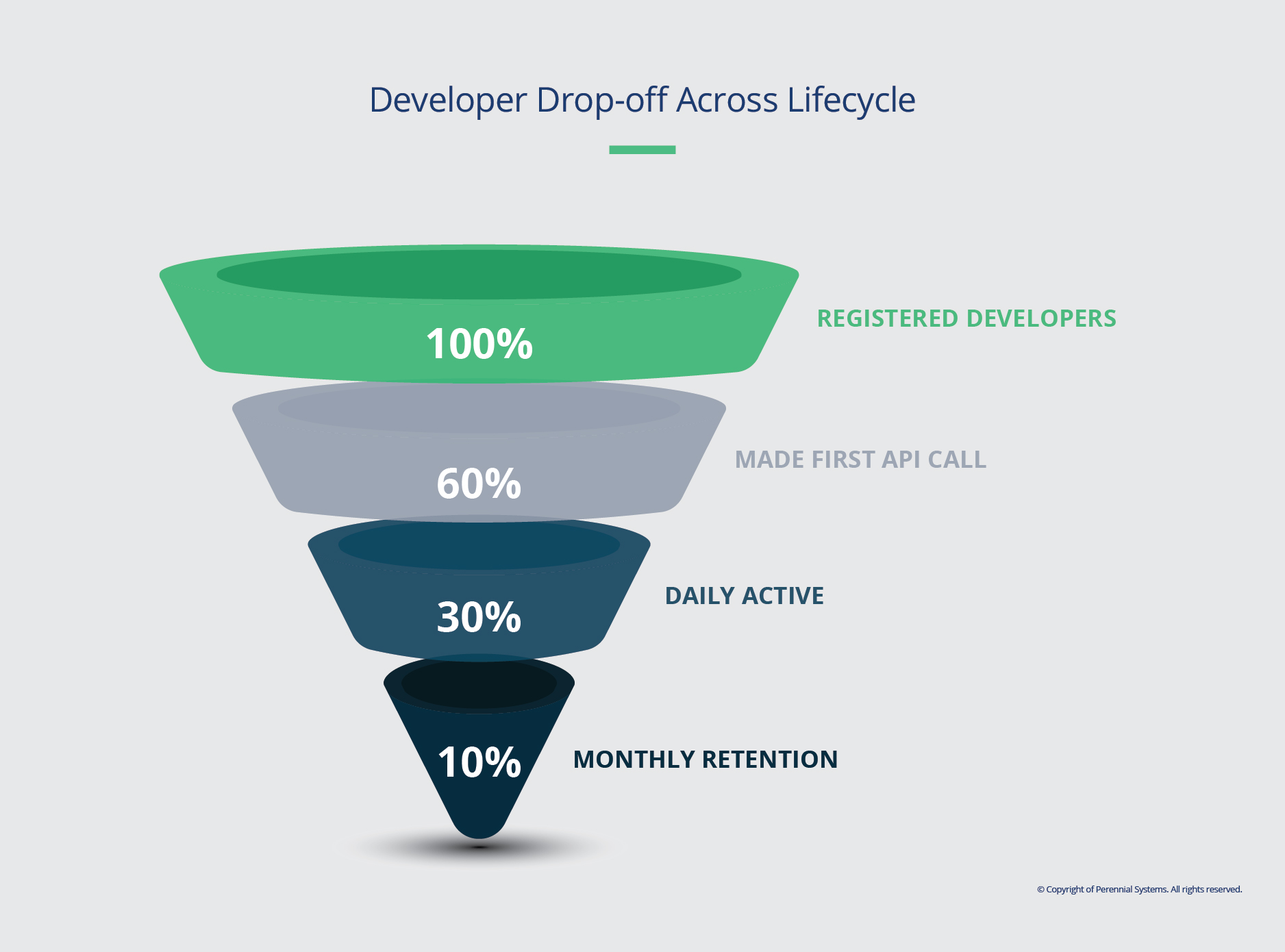
Cost Metrics: Financial Efficiency Across the API Lifecycle
APIs are not costless. Especially in high-throughput environments, even minor inefficiencies can balloon infrastructure bills.
What to measure:
Developer Hours per Integration: Understand where teams are stuck - API design? Docs? Sandbox instability?
API Gateway Cost per 1,000 Requests: Track this across internal, partner, and public APIs.
Maintenance Hours per Endpoint: How much time are teams spending maintaining low-impact APIs?
Cost-to-Failure Ratio: Every 5xx or 4xx has a price. Quantify it.
“A high-performing API should be efficient, not just available. Poorly governed endpoints can bleed cloud spend quietly.”
Strategic Benchmarks: Thinking Like a Product Manager
Borrowing from product management, API leaders should benchmark success across qualitative and quantitative dimensions:
Developer NPS or Feedback Scores: Sent quarterly to both internal and external users.
Feature Utilization Metrics: Which endpoints and query parameters are heavily used vs. ignored?
Version Migration Efficiency: Percentage of users moved within 90 days of a new release.
Contract Drift: Frequency of breaking changes or undocumented modifications.
This helps you make smart product decisions: What to double down on, what to repackage, and what to retire.
“We Will” Commitments (Action Framework)
We will:
Build your first API KPI dashboard using real-time logs, auth data, and feedback loops.
Set baseline benchmarks by integration time, usage, and gateway spend.
Define what “good” looks like for your org - driving toward API-as-a-Product mindset.
Run quarterly API scorecard reviews to guide sunset decisions and optimization planning.
10. What’s Next: API Trends and How to Future-Proof Your Strategy
The API space is shifting - fast. It’s not just about RESTful endpoints anymore. The future is composable, automated, and deeply intelligent.
Here are the top trends we’re tracking - and what they mean for your roadmap.
The Rise of Async APIs and the Decline of Polling
We’re entering an era where real-time responsiveness is expected. This is driving adoption of async-first designs - through webhooks, streaming APIs (like Kafka), and server-sent events.
Key shifts:
- GraphQL allows precise data fetching with fewer round trips.
- Webhooks and Event Meshes reduce constant polling and improve scalability.
- Streaming APIs allow subscription to data changes (great for analytics, inventory, or IoT).
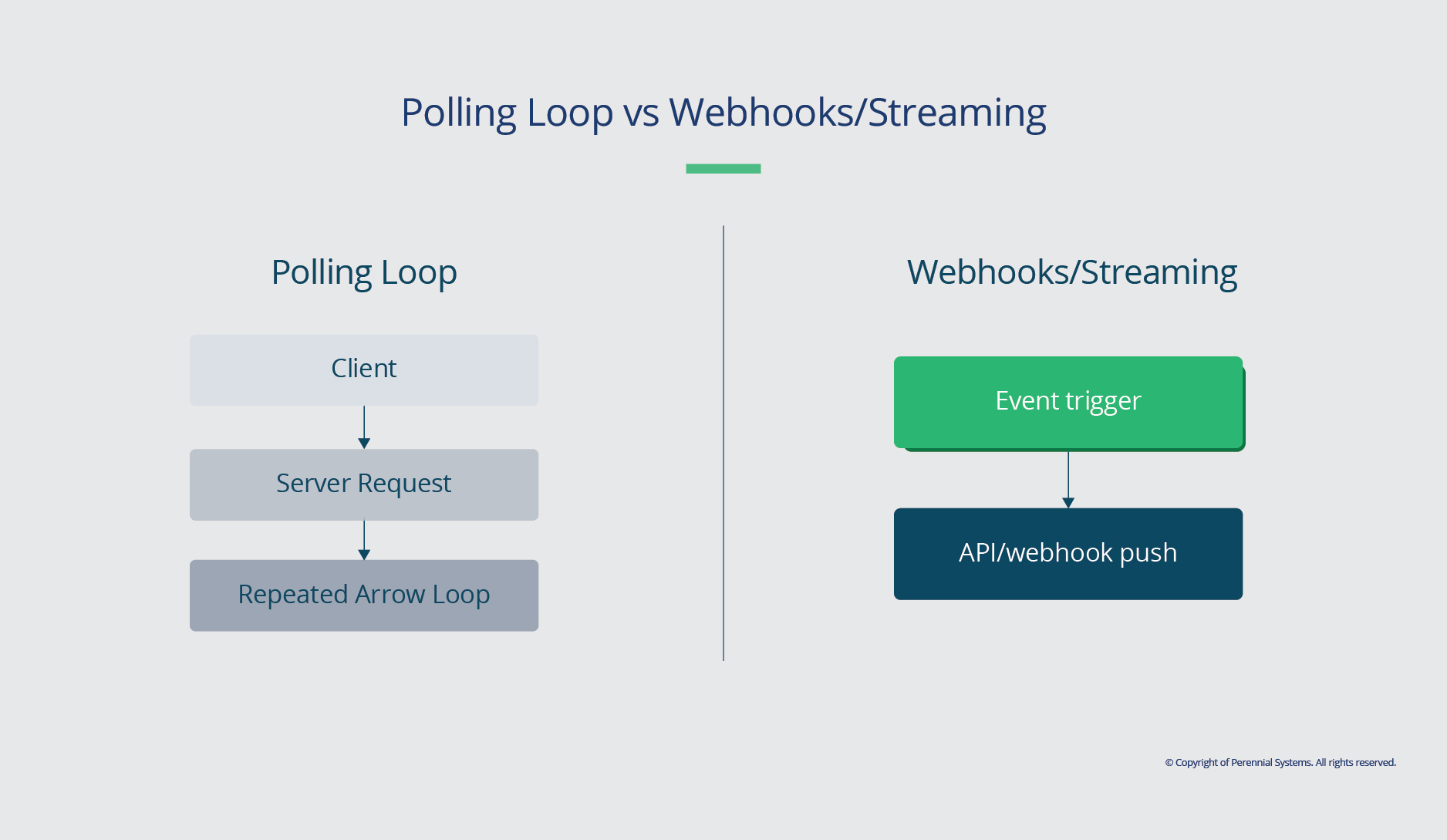
LLMs + OpenAPI: The Rise of Self-Documenting APIs
Documentation has always been a bottleneck - until now. With OpenAPI schemas and LLMs, it’s now possible to:
Auto-generate SDKs, usage examples, and changelogs
Build chat-style developer assistants that help teams understand and consume your APIs
Predict breaking changes before they go live
Expect tooling to evolve toward conversational APIs where devs interact in natural language - and get instant, code-ready answers.
“Docs will be dynamic. Contracts will be explainable. Support tickets will drop by 50%.”
Headless and Modular Architectures
The “headless” movement is no longer confined to CMSs. Modern enterprises are rebuilding digital infrastructure using headless commerce, data access, identity management, and more.
Composable Architecture means each function is now its own API, loosely coupled.
Stack complexity grows - so governance and versioning become critical.
Speed increases - teams can now replace or upgrade parts of their system without full rework.
What this means: Your API ecosystem must be modular, well-documented, and versioned properly to scale with business needs.
“We Will” Commitments (Action Framework)
We will:
Create a 12-month API Maturity Roadmap tailored to your tech stack and business goals.
Assess your readiness for GraphQL or Async upgrades, and build a phased migration plan.
Embed AI-powered documentation and contract generation into your current developer workflow.
Audit your current architecture to prepare for headless integrations across data, content, and commerce.
Final CTA
Talk to a Solution Architect – Get a free 30-min roadmap session
Try our API Maturity Scorecard – Assess where you are and what’s next
10. Acknowledgments
This guide was not just written - it was crafted. Behind the seamless experience of navigating these insights lies the effort of talented individuals who brought this vision to life.
Contributors
Medha Sharma
Medha Sharma is the Marketing Manager at Perennial Systems, where she leads content strategy and brand storytelling across technical domains. For this guide, she brought structure, clarity, and a sharp editorial lens - bridging engineering depth with narrative simplicity. Her work focuses on making complex ideas accessible, especially at the intersection of AI, product engineering, and digital transformation.
Design & Visual Experience
Anuja Hatagale
Anuja brought clarity and elegance to complex ideas through thoughtful visual design and layout. Her work ensured that every infographic, chart, and section feels intuitive and accessible.
Web Development & Publishing
Javed Tamboli
Javed translated the vision into a responsive, performant, and engaging digital experience. From interactive elements to seamless responsiveness, his technical craft made the guide as functional as it is insightful.


Varsha Shinde
Senior Technical Manager, Perennial Systems
About the Author
I’m Varsha Shinde, Senior Technical Manager at Perennial Systems, with 18+ years of experience in software engineering and platform architecture. My work focuses on building scalable, API-first systems, driving platform modernization, and leading DevOps and full-stack engineering teams.
Over the years, I’ve learned that impactful engineering isn’t just about writing clean code - it’s about designing systems that are resilient, maintainable, and aligned with real business needs. I’m deeply passionate about mentoring teams, shaping technical strategy, and turning complex challenges into opportunities for innovation.
Have insights to contribute to our blog? Share them with a click.

0 comments